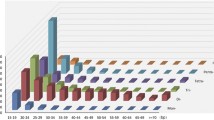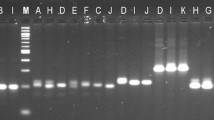Abstract
Saccharina latissima is an ecologically and economically important kelp species native to the coastal regions of the Northern Hemisphere. This species has considerable phylogeographic structure and morphological plasticity, but lack of resolution of available genetic markers prevents a finer characterization of its genetic diversity and structure. Here, we describe 12 microsatellite loci identified in silico in a genomic library, and assess their polymorphism in three distant populations. Allelic richness at the species level was relatively high (5–23 alleles per locus), as was gene diversity within populations (0.42 < H E < 0.62). In addition, individuals readily form distinct genotypic clusters matching their populations of origin. The variation detected confirms the great potential of these markers to investigate the biogeography and population dynamics of S. latissima, and to better characterize its genetic resources for the establishing farming industry.

Similar content being viewed by others
References
Alberto F (2009) MsatAllele-1.0: an R package to visualize the binning of microsatellite alleles. J Hered 100:394–397
Belkhir K, Borsa P, Chikhi L, Raufaste N, Bonhomme F (1996) GENETIX 4.05, logiciel sous Windows TM pour la génétique des populations. Laboratoire Génome, Populations, Interactions. Université de Montpellier II, Montpellier.
Gutiérrez JL, Jones CG, Byers JE, Arkema KK, Berkenbusch K, Commito JA, Duarte CM, Hacker SD, Lambrinos JG, Hendriks IE, Hogarth PJ, Palomo MG, Wild C (2011) Physical ecosystem engineers and the functioning of estuaries and coasts. In: Wolanski E, McLusky D (eds.) Treatise on Estuarine and Coastal Science, Vol 7, Elsevier pp. 53–81.
Martínez B, Afonso-Carrillo J, Anadón R, Araújo R, Arenas F, Arrontes J, Bárbara I, Borja A, Díez I, Duarte L, Fernández C, Tasende MG, Gorostiaga JM, Juanes JA, Peteiro C, Puente A, Rico JM, Sangil C, Sansón M, Tuya F, Viejo RM (2015) Regresión de las algas marinas en la costa atlántica de la Península Ibérica y en las Islas Canarias por efecto del cambio climático. Algas 49:5–12
Martins WS, Lucas DCS, Neves KFDS, Bertioli DJ (2009) WebSat—a web software for microsatellite marker development. Bioinformation 3:282–283
McDevit DC, Saunders GW (2010) A DNA barcode examination of the Laminariaceae (Phaeophyceae) in Canada reveals novel biogeographical and evolutionary insights. Phycologia 49:235–248
Moy FE, Christie H (2012) Large-scale shift from sugar kelp (Saccharina latissima) to ephemeral algae along the south and west coast of Norway. Mar Biol Res 8:309–321
Müller R, Laepple T, Bartsch I, Wiencke C (2009) Impact of oceanic warming on the distribution of seaweeds in polar and cold-temperate waters. Bot Mar 52:617–638
Peteiro C, Sánchez N, Dueñas-Liaño C, Martínez B (2014) Open-sea cultivation by transplanting young fronds of the kelp Saccharina latissima. J Appl Phycol 26:519–528
Smale DA, Burrows MT, Moore P, O’Connor N, Hawkins SJ (2013) Threats and knowledge gaps for ecosystem services provided by kelp forests: a northeast Atlantic perspective. Ecol Evol 3:4016–4038
Snirc A, Silberfeld T, Bonnet J, Tillier A, Tuffet S, Sun J-S (2010) Optimization of DNA extraction from brown algae (Phaeophyceae) based on a commercial kit. J Phycol 46:616–621
Steneck RS, Graham MH, Bourq BJ, Corbett D, Erlandson JM (2002) Kelp forest ecosystems, biodiversity, stability resilience and future. Environ Conserv 29:436–459
Toonen RJ, Hughes S (2001) Increased throughput for fragment analysis on an ABI Prism® 377 automated sequencer using a membrane comb and STRand software. BioTechniques 31:1320–1324
Van Oosterhout C, Hutchinson WF, Wills DPM, Shipley P (2004) MICRO-CHECKER: software for identifying and correcting genotyping errors in microsatellite data. Mol Ecol Notes 4:535–538
Acknowledgments
This work was funded by Portuguese Fundação para a Ciência e Tecnologia (FCT) through the project EXTANT (EXCL/AAG-GLO/0661/2012) and postdoctoral fellowship to JN (SFRH/BPD/88935/2012), and through the European Union’s Seventh Framework Programme, grant agreement no. 226248—Arctic Tipping Points (ATP).
Author information
Authors and Affiliations
Corresponding author
Rights and permissions
About this article
Cite this article
Paulino, C., Neiva, J., Coelho, N.C. et al. Characterization of 12 polymorphic microsatellite markers in the sugar kelp Saccharina latissima . J Appl Phycol 28, 3071–3074 (2016). https://doi.org/10.1007/s10811-016-0811-x
Received:
Revised:
Accepted:
Published:
Issue Date:
DOI: https://doi.org/10.1007/s10811-016-0811-x




